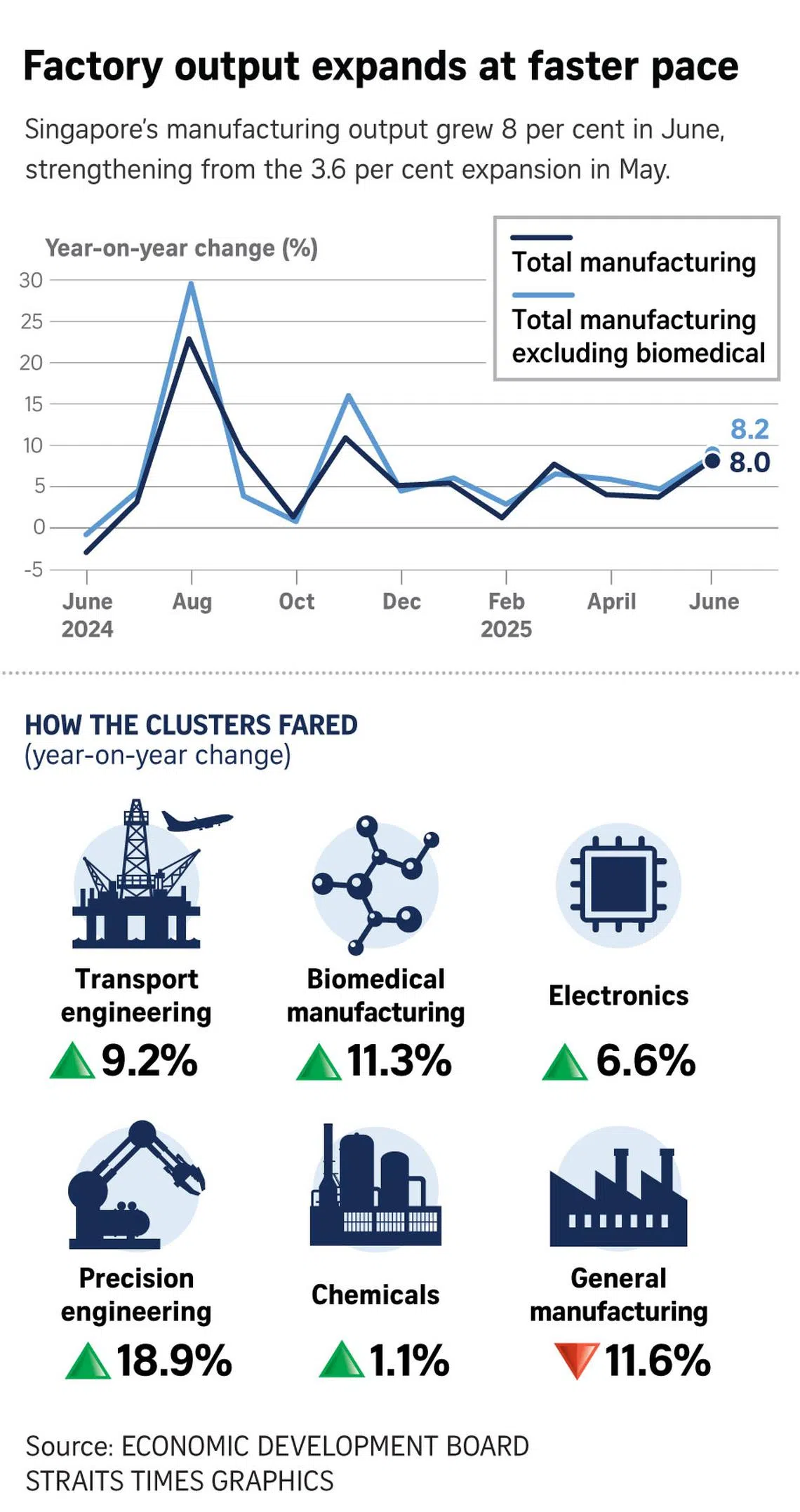Singapore factory output growth quickens in June, but economists see pullback ahead as tariffs hit
Sign up now: Get ST's newsletters delivered to your inbox

Output rose 8 per cent year on year, after a revised 3.6 per cent increase in May, data from the Economic Development Board on July 25 showed.
ST PHOTO: LIM YAOHUI
Follow topic:
- Maufacturing bump topped forecasts, driven by front-loading of orders before US reciprocal tariffs kick in.
- Economists predict a slowdown in second half year.
- Demand will feel effects of "payback" from the front-loading and the tariff hit.
AI generated
SINGAPORE – Singapore’s manufacturing output picked up pace in June, topping forecasts, but production is expected to slow in the second half of 2025 as US tariffs kick in.
Output rose 8 per cent year on year, after a revised 3.6 per cent increase in May, data from the Economic Development Board on July 25 showed.
The figure surpassed a 7.1 per cent growth forecast by economists in a Bloomberg poll.
Excluding the more volatile biomedical industry, production increased 8.2 per cent.
On a seasonally adjusted month-on-month basis, manufacturing output in June was largely unchanged from the previous month. Excluding biomedical manufacturing, output declined 0.8 per cent.
Since US President Donald Trump first announced global “reciprocal” tariffs on April 2, businesses have been front-loading orders – importing goods early to avoid the hefty incoming levies that will kick in on Aug 1.
Economists expect “payback” from this front-loading to hit in the second half of 2025, along with the ripple effects of reciprocal tariffs.
The pain to exports, and thus manufacturing, will be greater if Mr Trump goes ahead and slaps sectoral tariffs on semiconductors and pharmaceuticals – sectors important to Singapore’s economy.
DBS Bank senior economist Chua Han Teng noted that June’s output growth was the fastest since November 2024, but attributed this partly to base effects.
He maintains a cautious outlook for the second half of 2025. “The resilience in the first half of 2025 was supported by the front-loading of export orders, which will eventually be followed by a payback through decelerating trade and industrial production that would materialise in the second half,” he added.
He highlighted that reciprocal US tariff rates for most countries remain unannounced ahead of the Aug 1 implementation date.
“These rates could be higher than the current global baseline 10 per cent rate, with US President Donald Trump suggesting on July 24 that he would not go below 15 per cent,” said Mr Chua.
“Statistically also, base effects for factory output will be high in the second half of 2025,” he added.
OCBC Bank’s chief economist Selena Ling said the bigger question is whether there would be any concessions given for the sectoral tariffs that could be impending for semiconductors and pharmaceuticals.
Any tariffs on semiconductors and pharmaceuticals could mean a bigger hit to domestic manufacturing growth ahead, she warned.
For June, all manufacturing industries, with one exception, saw year-on-year output growth.
In the key electronics sector, output rose 6.6 per cent, up from a revised 3.4 per cent expansion in May.
The infocomms and consumer electronics segment expanded 22.4 per cent, down from growth of 42.6 per cent in the previous month.
Semiconductor production climbed 4.3 per cent, up from the 3.1 per cent increase in May.

Computer peripherals and the data storage segment contracted 14.6 per cent while other electronic modules and components shrank 14.8 per cent.
Precision engineering was the top performer in manufacturing, expanding 18.9 per cent.
The machinery and systems segment increased 19.3 per cent, led by higher production of semiconductor equipment and process control equipment. The precision modules and components segment grew 17.9 per cent, attributed to higher output in the plastic and metal precision component, optical instrument and electronic connector industries.
Biomedical manufacturing output increased 11.3 per cent in June, up from 4.6 per cent growth in May.
The pharmaceuticals segment expanded 38.8 per cent due to a low base effect from a year ago. The medical technology segment declined 2.5 per cent, from 5.6 per cent growth in May.
Transport engineering output grew 9.2 per cent, thanks to the aerospace segment’s 20.6 per cent expansion, bolstered by higher production of aircraft parts and more maintenance, repair and overhaul jobs from commercial airlines.
The marine and offshore engineering segment declined 2.6 per cent, attributed to lower production of oil and gas field equipment, while the land segment fell 11.7 per cent.
Chemicals output increased 1.1 per cent compared with a year ago, with most segments reporting growth.
The petrochemicals segment grew 6.9 per cent, partly because of a low production base a year earlier from plant maintenance shutdowns.
The other chemicals segment grew 5 per cent from higher output of fragrances and the petroleum segment expanded 1.8 per cent. However, the specialities segment declined 6.5 per cent on the back of lower production of industrial gases, biofuels and food additives.
General manufacturing output dropped 11.6 per cent, dragged down by most of the segments.
While the printing segment grew 2.5 per cent, the food, beverages and tobacco one declined 12.7 per cent with lower production of beverage products and milk powder.
The miscellaneous industries segment contracted by 11.6 per cent, mainly due to lower output of structural metal components and products as well as paper and paperboard containers and boxes.

